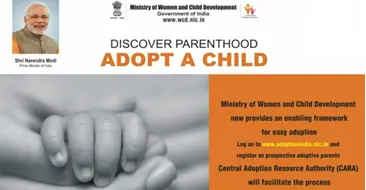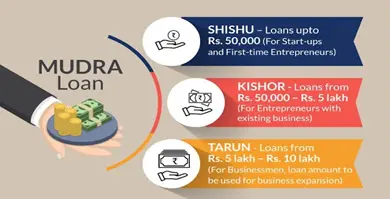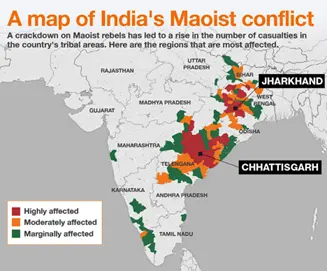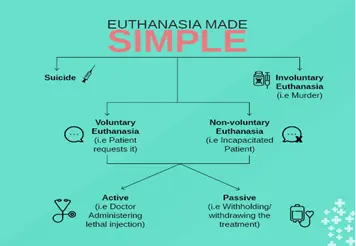Thursday, 29th August 2024
The two new US-India Defence agreements
Why in the news?
- India and the US recently signed two significant defence agreements: the Security of Supply Arrangement (SOSA) and a Memorandum of Agreement on the Assignment of Liaison Officers.
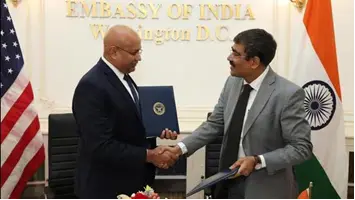
- Both nations also agreed to enhance co-production projects as part of the 2023 US-India Roadmap for Defence Industrial Cooperation.
What are the Key Defence Agreements Signed Between India and the US?
- Security of Supply Arrangement (SOSA):
- SOSA is an agreement between India and the US, making India the 18th SOSA partner of the US.
- Allows both countries to prioritise each other’s goods and services for national defence, ensuring supply chain resilience during emergencies.
- Facilitates expedited deliveries for defence contractors in both countries.
- Although non-binding, it operates on mutual goodwill with Indian companies prioritising US orders.
- The US provides assurances through its Defense Priorities and Allocations System (DPAS).
- MoU on Liaison Officers:
- Enhances information-sharing by establishing a system of Liaison Officers between India and the US.
- Begins with the deployment of an Indian officer to the US Special Operations Command in Florida.
- Builds on prior agreements like the 2013 Joint Declaration on Defence Cooperation.
- Reciprocal Defence Procurement (RDP) Agreement:
- India and the US are negotiating an RDP Agreement, which is yet to be finalised.
- Aims to enhance the rationalisation, standardisation, and interoperability of defence equipment.
- Allows US companies to bypass certain procurement restrictions like India's "Make in India" initiative.
- Promotes the establishment of manufacturing bases in India and collaboration with local firms.
- SOSA vs. RDP:
- SOSA focuses on maintaining the defence supply chain during crises.
- RDP establishes a legally binding framework prioritising defence orders and facilitating joint production and technological collaboration.
What are the Developments in India-US Defence Cooperation?
- GSOMIA: Laid the foundation for India-US defence cooperation in 2002 by facilitating the sharing of sensitive military information.
- LEMOA: Established a framework for reciprocal logistical support between the two militaries in 2016.
- COMCASA: Enhanced secure military communications and access to advanced defence technologies in 2018.
- BECA: Enabled the sharing of geospatial data critical for military operations in 2020.
- 2+2 Dialogue: Supported by joint exercises and facilitated deeper collaboration.
- Strategic Trade Authorization Tier-1 Status: Granted to India in 2018, allowing access to advanced technologies.
- DTTI: Established in 2012 to streamline defence trade and promote co-production and co-development of defence technologies.
- Military Procurement: Includes MH-60R Seahawk helicopters, Sig Sauer rifles, and M777 howitzers from the US.
- INDUS-X: Launched in 2023 to foster defence innovation and industrial cooperation.
- I2U2 Grouping: Includes India, Israel, the US, and the UAE, focusing on joint investments in various sectors, including defence.
Challenges to India-US Relations:
- Human Rights and Democratic Values:
- Tensions arise from concerns over India’s treatment of minorities, including Muslims.
- Controversial policies such as the Citizenship Amendment Act (CAA) and the revocation of Jammu and Kashmir's special status raise questions about India's commitment to secularism and tolerance.
- Strategic Competition with China:
- Both nations view China as a strategic challenge but sometimes have differing approaches. India’s economic ties with China occasionally clash with US interests, causing friction.
- Trade and Economic Disputes:
- Trade issues, protectionist policies, and disputes over market access and intellectual property rights complicate the pursuit of a comprehensive trade agreement.
- Geopolitical Alignment:
- The legacy of India's non-alignment during the Cold War, which involved closer ties with the Soviet Union, affects current perceptions and expectations.
- India’s balancing act between the US and Russia, especially regarding Russia's actions in Ukraine, can create tension.
Way Forward
- Address Diplomatic Concerns: Resolve diplomatic tensions by focusing on democracy and strategic cooperation, utilising initiatives like the iCET to bridge gaps.
- India’s Role as a Global Bridge: Leverage India’s leadership in global forums such as the G20 and SCO to bridge differences between the West and developing nations.
- Enhance Counterterrorism Cooperation: Strengthen counterterrorism efforts, particularly in managing Taliban-led Afghanistan and pressuring Pakistan to curb support for terrorist groups.
- Focus on Emerging Technologies and AI: Collaborate on emerging technologies and AI, emphasising data regulation, information sharing, and privacy to enhance national security.
- Advance Multilateral Coordination: Prioritise coordination in multilateral forums like the Quad and I2U2 to address international strategic issues.
- Boost Economic Engagement: Increase trade, investment, and technological cooperation, with initiatives like iCET driving economic growth and market access.
|
UPSC Civil Services Examination, Previous Year Question (PYQ) Prelims: Q:1 From which one of the following did India buy the Barak anti-missile defence systems? (2008)
Ans: (a)
Q:2 Recently, the USA decided to support India’s membership in multilateral export control regimes called the “Australia Group” and the “Wassenaar Arrangement”. What is the difference between them? (2011)
Which of the statements given above is/are correct?
Ans: (d)
Mains: Q:1 What is the significance of Indo-US defence deals over Indo-Russian defence deals? Discuss with reference to stability in the Indo-Pacific region. (2020) Q:2 ‘What introduces friction into the ties between India and the United States is that Washington is still unable to find for India a position in its global strategy, which would satisfy India’s National self-esteem and ambitions’. Explain with suitable examples. (2019) |
Advancing Equity, From COVID-19 to Mpox
Why in the news?
- The world faces a new health threat with the mpox outbreak (formerly monkeypox), shortly after the COVID-19 pandemic, with declarations from the WHO and Africa CDC.
- The recent declaration of Mpox (formerly monkeypox) as a Public Health Emergency of International Concern (PHEIC) by the WHO highlights several critical lessons learned from the COVID-19 pandemic.
The Emergence of Mpox as a Global Health Crisis
- Transition to Global Emergency: Mpox has evolved from a regional issue in the Democratic Republic of the Congo (DRC) to a global health emergency.
- WHO's PHEIC Declaration: The WHO declared mpox a Public Health Emergency of International Concern (PHEIC), reflecting the new IHR amendments that include equity as a core principle.
- Global Response Imperative: The global response must prioritise equity to ensure that all nations, especially those in the Global South, receive adequate support and resources.
Lessons from the COVID-19 Pandemic on Vaccine Equity and Manufacturing
- Vaccine Distribution Inequities: High-income countries secured vaccines early, leading to inequitable distribution.
- Hoarding and Limited Access: High-income countries obtained vaccines quickly through advance purchase agreements, causing hoarding and limited access for lower-income nations.
- COVAX's Role and Limitations: Despite global initiatives like COVAX, vaccine distribution remained skewed towards wealthier nations. Many low-income countries lagged behind in their vaccination efforts.
- Technology Transfer Challenges: Limited technology transfer hindered equitable vaccine production.
- Importance of Technology Transfer: Sharing knowledge and expertise for local vaccine production is critical for addressing inequities.
- Reluctance to Share: Many pharmaceutical companies and high-income countries hesitated to share intellectual property and manufacturing expertise, delaying local production in lower-income countries.
- Oxford/AstraZeneca Case: The production of Covishield in India showcases successful technology transfer.
- Role of Serum Institute of India (SII): SII was granted the rights to produce Covishield, enabling mass distribution in India and other low- and middle-income countries.
- Demonstration of Potential: This case illustrates how technology transfer can help bridge vaccine access gaps.
Mpox and the Opportunity for a Different Approach
- Existing Vaccine Advantage: The MVA-BN (Jynneos) vaccine offers a chance to apply lessons learned from COVID-19.
- Approved Vaccine: Unlike COVID-19 vaccines that required development from scratch, MVA-BN is already approved and in production.
- Avoiding Past Mistakes: Effective management of the mpox outbreak requires avoiding the mistakes made during the COVID-19 response.
- Equitable Distribution: Ensuring fair distribution of the MVA-BN vaccine is crucial.
- Prioritising Technology Transfer: Focus on transferring technology to countries with manufacturing capabilities but lacking expertise.
- India’s Role: India’s pharmaceutical industry, including SII and other manufacturers, can scale up production if given technological support.
Way Forward:
- Expansion of Manufacturing in the Global South: Diversifying vaccine manufacturing is essential to address inequities.
- Avoiding Bottlenecks: Reliance on high-income countries created bottlenecks during COVID-19. Expanding manufacturing across regions can improve resilience.
- Investment in Infrastructure and Capacity Building: Enhancing manufacturing capabilities in LMICs is critical.
- Infrastructure and Training: Investments should focus on both physical infrastructure and training to meet international standards, creating a more self-sufficient health system.
- Economic and Ethical Imperatives: Vaccine equity is both an economic and ethical necessity.
- Moral and Strategic Failures: The COVID-19 pandemic demonstrated that inequity is not just a moral failure but a strategic error. Ensuring equitable vaccine access for mpox is vital for global health security.
Conclusion
The COVID-19 pandemic revealed the severe consequences of vaccine inequity. The mpox outbreak provides an opportunity to address these issues and establish a model for future public health responses based on equity and solidarity.
|
UPSC Civil Services Examination PYQ Mains Q:1 COVID-19 pandemic has caused unprecedented devastation worldwide. However, technological advancements are being availed readily to win over the crisis. Give an account of how technology was sought to aid the management of the pandemic. (2016) |
Source: TH
Ten Years of Pradhan Mantri Jan-Dhan Yojana
Why in the news?
- The Pradhan Mantri Jan-Dhan Yojana (PMJDY) marks its tenth anniversary in 2024. Launched on August 28, 2014, the government aims to open over 3 crore accounts under PMJDY during the financial year 2024-25.
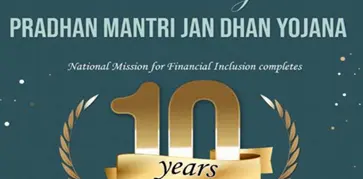
What are the Achievements of Pradhan Mantri Jan-Dhan Yojana?
- Account Expansion: PMJDY has significantly expanded from 147 million accounts in March 2015 to 520 million accounts in March 2024.
- Deposit Mobilisation:
- Deposits under PMJDY grew from Rs 15,600 crore in March 2015 to Rs 2.32 trillion in March 2024, reflecting a compound average growth rate of 30% over the last decade.
- The average balance per account increased from Rs 1,065 in March 2015 to Rs 4,476 in March 2024.
- Expansion of Banking Infrastructure:
- Over 1.3 million banking touchpoints have been mapped on the Jan Dhan Darshak (JDD) App, with 601,000 villages covered as of July 2023.
- Out of these, 599,468 villages (99.7%) have access to banking outlets within a 5 km radius.
- Rural-Urban Parity: As of 2024, PMJDY accounts total 53.13 crores, with 55.6% held by women and 66.6% in rural and semi-urban areas.
- Boost in Digital Payments: UPI financial transactions surged from 920 million in FY 2018 to 131.2 billion in FY 2024. Similarly, RuPay card transactions at PoS and e-commerce sites increased from 670 million in FY 2018 to 1.26 billion in FY 2023.
- Direct Benefit Transfer (DBT):
- PMJDY facilitated the transfer of approximately USD 361 billion to beneficiaries across 312 key schemes from 53 central government ministries.
- During COVID-19, it played a crucial role in disbursing one-time ex gratia payments under the Pradhan Mantri Garib Kalyan Yojana (PMGKY) to 206.4 million women account holders.
- Overdraft (OD) Accounts: As of March 2024, 1,17,701 overdraft facilities have been sanctioned under PMJDY, amounting to Rs 190 crore, with an 80.5% utilisation rate.
- Low Zero Balance Accounts: Despite the allowance of zero-balance accounts, only 8.4% of PMJDY accounts remain with zero balance.
- Praised by the World Bank: The World Bank highlighted that India achieved financial inclusion rates of 80% of adults, a journey shortened by up to 47 years due to the Digital Public Infrastructure (DPI) and the JAM trinity (Jan Dhan-Aadhaar-Mobile).
What is PMJDY?
- About:
- PMJDY is a financial inclusion initiative aimed at providing access to financial services such as savings and deposit accounts, remittances, credit, insurance, and pensions at an affordable cost.
- A basic savings bank deposit (BSBD) account can be opened at any bank branch or Business Correspondent (Bank Mitra) outlet by individuals without any other accounts.
Features:
- No Minimum Balance: PMJDY accounts do not require a minimum balance.
- Free Debit Card: Account holders receive a free Rupay Debit card.
- Accident Insurance: Accidental insurance coverage of Rs 1 lakh, enhanced to Rs 2 lakh for accounts opened since 2018, is provided.
- OD Facility: Eligible account holders can avail of an overdraft facility of up to Rs 10,000.
- DBT Benefits:
- PMJDY accounts are eligible for DBT and schemes like Pradhan Mantri Jeevan Jyoti Bima Yojana (PMJJBY), Pradhan Mantri Suraksha Bima Yojana (PMSBY), Atal Pension Yojana (APY), and MUDRA scheme.
- However, a free cheque book facility is not mandatory for PMJDY accounts.
What are the Challenges Associated with PMJDY?
- Multiple Accounts: The benefits of insurance and overdraft facilities may prompt individuals to open multiple accounts using different identification documents, leading to account duplication.
- Economic Burden on Banks: Managing a large number of accounts with low balances poses financial challenges for banks.
- Money Laundering: There is concern that Jan Dhan accounts may be misused for money laundering, especially post-demonetisation.
- Declining Overdraft Facility: The decision to extend the OD facility lies with individual banks, and many decline to provide it, defeating the scheme's purpose.
- Misuse of Authority: Business Correspondents (BCs) may exploit their authority, imposing extra fees for services that should be free or low-cost.
- Bad Loans: The overdraft facility could potentially result in bad loans for banks, with past debt waivers leading to perceptions of loans as freebies.
- Financial and Technology Illiteracy: Many rural people lack the financial literacy necessary to make informed decisions about savings, borrowings, and investments. A survey by Visa revealed that 65% of Indians lack financial literacy.
Way Forward
- Centralised Verification System: Implement a centralised system using biometric and digital identity verification to prevent account duplication. Offer incentives to encourage individuals to maintain a single account, such as enhanced benefits or reduced fees.
- National Strategy for Financial Inclusion (NSFI): The upcoming NSFI for 2025-30 should prioritise expanding social security schemes and raising awareness among targeted populations.
- Insurance for All: The focus should shift from account creation to ensuring coverage under micro-insurance schemes, improving access to micro-credit, and encouraging micro-investments like flexi-recurring deposits.
- Increased Penetration of OD Accounts: Enhance the penetration of OD accounts to make PMJDY a catalyst for growth and a contributor to Viksit Bharat.
- New Focus Areas: The Centre's focus should now include covering the entire adult population and continuing to cover those acquiring adulthood, ensuring that PMJDY reaches its full potential.
|
UPSC Civil Services Examination, Previous Year Question (PYQ) Prelims Q:1 Priority Sector Lending by banks in India constitutes the lending to (2013)
Ans: (d)
Q:2 ‘Pradhan Mantri Jan-Dhan Yojana’ has been launched for (2015)
Ans: (c)
Mains Q:1 Pradhan Mantri Jan Dhan Yojana (PMJDY) is necessary for bringing unbanked to the institutional finance fold. Do you agree with this for financial inclusion of the poor section of the Indian society? Give arguments to justify your opinion. (2016) Q:2 Among several factors for India’s potential growth, the savings rate is the most effective one. Do you agree? What are the other factors available for growth potential? (2017) |
Preventing Misleading Ads About Ayurvedic, Siddha
Why in the news?
- The Supreme Court of India has stayed a notification issued by the Ministry of AYUSH that omitted Rule 170 of the Drugs and Cosmetics Rules, 1945.
- This rule pertains to the authority to take action against objectionable or misleading advertisements related to Ayurvedic, Siddha, and Unani drugs.
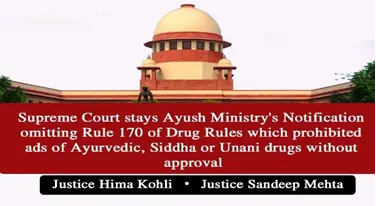
How Misleading Advertisements are Regulated in India?
- Misleading Advertisement:
- Defined under Section 2 (28) of the Consumer Protection Act, 2019.
- Includes false descriptions, false guarantees, unfair trade practices, and omission of essential product information.
- Central Consumer Protection Authority (CCPA):
- Operates under the Department of Consumer Affairs, established under the Consumer Protection Act, 2019.
- Empowers CCPA to prevent false/misleading ads and protect consumer rights.
- Enforcement of Guidelines:
- CCPA enforces guidelines from 2022 to prevent misleading advertisements.
- Focuses on unsubstantiated claims, exaggerated promises, and misinformation.
- Objective of the Guidelines:
- Protects consumers from false claims and ensures rights to information, choice, and safety.
- Provisions of the Guidelines:
- Defines terms like "bait advertising," "surrogate advertisement."
- Protects children from exaggerated claims and restricts certain endorsements.
- Disclaimers must be clear; duties of advertisers are outlined for transparency.
- Penalties for Violations:
- CCPA can impose fines up to ₹10 lakh for violations; repeat offences up to ₹50 lakh.
- Endorsers can be banned for 1 year, extending to 3 years for repeat offences.
- Food Safety and Standards Authority of India (FSSAI):
- Regulates deceptive food advertising under the Food Safety and Standards Act, 2006.
- Enforces truthfulness and scientific substantiation in food ads.
Legislations Governing Advertising:
- ASCI: A nonstatutory self-regulatory body that enforces advertising ethics via the ASCI Code.
- Consumer Protection Act, 1986: Covers false ads under unfair trade practices; provides consumer redressal.
- Cable Television Network Act, 1995 & Amendment, 2006: Prohibits nonconforming ads; safeguards decency and morality.
- Restrictions on Tobacco Advertisement: Prohibits tobacco ads in media under the Cigarettes and Other Tobacco Products Act, 2003.
- Drug and Magic Remedies Act, 1954 & Drugs and Cosmetics Act, 1940: Regulates drug ads; prohibits misuse of test reports.
- Regulation of Prenatal Diagnostic Techniques: Bans prenatal sex determination ads under the 1994 Act.
- Indian Penal Code (IPC): Criminalizes obscene, defamatory, or inciteful advertisements.
- Central Drugs Standard Control Organisation (CDSCO):
- The CDSCO operates under the Directorate General of Health Services, Ministry of Health & Family Welfare, and serves as the National Regulatory Authority (NRA) of India.
- Under the Drugs and Cosmetics Act, the CDSCO is responsible for:
- Approval of Drugs.
- Conduct of Clinical Trials.
- Establishment of Drug Standards.
- Quality control of imported drugs in the country.
- Coordination with State Drug Control Organisations.
- The CDSCO, along with state regulators, is also responsible for granting licences for specialised categories of critical drugs such as vaccines and sera.
- Drugs Controller General of India (DCGI):
- The DCGI, head of the CDSCO, is responsible for approving licences for specific categories of drugs such as blood products, vaccines, and sera.
- The DCGI also sets standards for the manufacturing, sale, import, and distribution of drugs in India.
About Ayurvedic, Siddha, and Unani Drugs:
- Definition: According to the Drugs and Cosmetics Act, 1940, Ayurvedic, Siddha, and Unani drugs are defined as medicines used internally or externally for the treatment, prevention, mitigation, or diagnosis of diseases or disorders in humans or animals.
- Regulation:
- The Act establishes the Ayurvedic, Siddha, and Unani Drugs Technical Advisory Board (ASUDTAB), which is responsible for setting standards for these drugs.
- The Central Government can modify or create new rules concerning these drugs after consulting the board.
- Schedule T under the Drugs and Cosmetics Act, 1940: Schedule T outlines the Good Manufacturing Practices (GMP) for Ayurvedic, Siddha, and Unani medicines.
The Supreme Court’s Efforts to Protect Consumers from Misleading Ads:
- In a contempt case against Patanjali Ayurved Limited, the Supreme Court (on May 7, 2024) directed advertisers to submit self-declarations affirming that they are not misrepresenting or making false claims about products before promoting them in the media.
- Despite this, the Ministry of AYUSH (on July 1, 2024) notified the omission of Rule 170 of the Drugs and Cosmetics Rules, 1945.
- The ministry's decision was based on a recommendation made by the ASUDTAB.
- In its recent order, the Supreme Court has stayed the Centre’s notification (dated July 1, 2024) to omit Rule 170 of the Drugs and Cosmetics Rules, 1945, as it contradicts the court’s earlier directions.
|
UPSC Civil Services Examination Previous Year Question Prelims Q.1 With reference to ‘consumers’ rights/privileges under the provisions of law in India, which of the following statements is/are correct? (2012)
Select the correct answer using the codes given below:
Ans: (c)
Mains Q1. What are social networking sites and what security implications do these sites present? (2013) |
Source: TOI
Supreme Court Judgement in Delhi excise policy case
Why in the news ?
- The Supreme Court granted bail to BRS leader K Kavitha in connection with graft and money laundering cases related to the Delhi excise policy scam.
- The Court referenced its previous ruling in the Manish Sisodia case, underscoring that undertrial custody should not be punitive.
- It also highlighted Section 45(1) of the Prevention of Money Laundering Act (PMLA), which provides special consideration for women in granting bail.
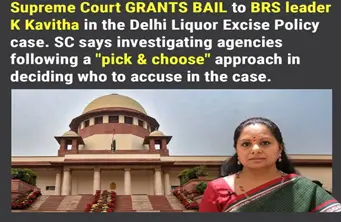
Section 45 of the PMLA:
- About:
- Section 45 of the Prevention of Money Laundering Act (PMLA) outlines the conditions for granting bail.
- It mandates that no accused person shall be granted bail unless:
- The Public Prosecutor has been given an opportunity to oppose the application for such release; and
- If the Public Prosecutor opposes the application, the Court must be satisfied that:
- There are reasonable grounds for believing the accused is not guilty of the offence; and
- The accused is unlikely to commit any offence while on bail.
- This section sets a high threshold for granting bail, indicating that bail under the PMLA is the exception rather than the rule.
- Twin Test of Bail under Section 45 of PMLA:
- The twin conditions for bail under Section 45 of the PMLA present stringent requirements for the accused.
- Firstly, the accused must demonstrate prima facie innocence.
- Secondly, the accused must convince the court that they will not commit any offence while on bail.
- The burden of proof lies entirely on the accused, often leaving them at a disadvantage against the state's resources.
- These twin conditions make securing bail under the PMLA extremely difficult.
- Exceptions:
- An important exception allows bail for women, minors (under 16), or those who are sick or infirm, provided the Special Court permits it.
- This exception is similar to provisions in the Indian Penal Code, which offer special consideration for women and minors.
- Legal Precedent for Such Exceptions:
- In 2023, the Delhi High Court granted bail to Preeti Chandra, wife of Sanjay Chandra, under the exception for women in Section 45(1) of the PMLA.
- The Enforcement Directorate (ED) argued that she was not a "household lady."
- However, the Court rejected this distinction, stating that neither the PMLA nor the Constitution differentiates between types of women, whether they are household women, businesswomen, or political figures.
- The Court criticised attempts to create sub-classifications within the broader category of "woman," deeming it misconceived.
- The Court also clarified that to be eligible for bail, the accused must not be a flight risk or likely to tamper with witnesses.
Key Highlights of the Judgement:
- Background of the Case:
- The CBI, in its charge sheet, alleged that BRS MLC K Kavitha "demanded, collected, and provided" ₹100 crore to the Aam Aadmi Party (AAP) to influence the now-scrapped Delhi excise policy.
- The Enforcement Directorate (ED) claimed that Kavitha was part of a "South Group" that received undue favours and stakes in wholesale businesses and retail zones from AAP leaders in exchange for the money.
- The alleged bribes were reportedly used to fund AAP’s 2022 Goa Assembly election campaign.
- The ED named Kavitha as an accused in its sixth supplementary chargesheet.
- About the Judgement:
- Bail Justification:
- The Court stated that since the investigation is complete and the chargesheet has been filed, Kavitha's custody is no longer necessary.
- She has been in jail for five months, and the trial is unlikely to conclude soon.
- The Court emphasised that undertrial custody should not become a form of punishment.
- Criticism of the Delhi High Court's Ruling:
- The Court criticised a Delhi High Court ruling that denied bail to an educated, sophisticated woman under the PMLA's beneficiary provision for women.
- It warned that if such reasoning became law, it would mean no educated woman could get bail, affecting courts in Delhi's jurisdiction.
- The Court rejected the idea of creating distinctions between an MP and a common person, stating that the High Court's reasoning introduced an artificial discretion does not present in the statute.
- Bail Justification:
Source: TH
Talley Valley Wildlife Sanctuary
Why in the news?
- A Mumbai-based lepidopterist recently documented 85 butterfly species during a four-day expedition in Talley Valley Wildlife Sanctuary, situated in Arunachal Pradesh’s Lower Subansiri district.
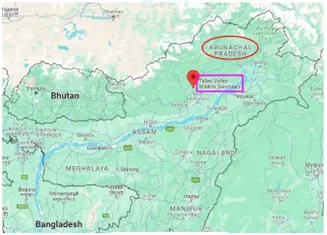
About Talley Valley Wildlife Sanctuary:
- Location and Geography:
- District: Lower Subansiri, Arunachal Pradesh.
- Area: Covers 337 sq. km.
- Altitude: Located at 2400 metres above sea level.
- Rivers: Includes rivers like Pange, Sipu, Karing, and Subansiri flowing through the sanctuary.
- Cultural Significance:
- Inhabitants: The sanctuary is home to the Apatani tribe, renowned for their distinctive customs, traditions, and handicrafts.
- Flora:
- Forests: Features a rich diversity of subtropical and alpine forests, including silver fir trees, ferns, orchids, bamboo, and rhododendrons.
- Unique Species: The sanctuary is the only known habitat of Pleioblastus simone, a rare species of bamboo.
- Medicinal Plants: Hosts several medicinal plants and herbs utilized by the local tribes in traditional medicine.
- Fauna:
- Wildlife: Inhabited by various species including elephants, barking deer, giant squirrels, porcupines, leopards, clouded leopards, wild boars, and more.
Source: NN
Geoglyphs
Why in the news?
- The Maharashtra government recently declared 1,500 geoglyphs across 70 locations in Ratnagiri district as a ‘protected monument.’
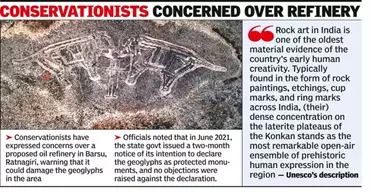
About Geoglyphs:
- Definition: A geoglyph is a large design or motif created on the ground, typically using natural elements like stones, gravel, or earth.
- Size: Geoglyphs are usually more than four metres in length.
- Visibility: While geoglyphs are difficult to identify from the ground, they are best appreciated when viewed from the sky.
- Types of Geoglyphs:
- Positive Geoglyph: Created by arranging and aligning materials on the ground, similar to petroforms (outlines made with boulders).
- Negative Geoglyph: Formed by removing part of the natural ground surface to expose differently coloured or textured areas, akin to petroglyphs.
- Variations:
- Arborglyph: A type of geoglyph involving the planting of trees or plants in a specific design, which becomes visible as the vegetation grows over time.
- Chalk Giants: Geoglyphs carved into hillsides, exposing the underlying bedrock. These are often referred to as "chalk giants."
Examples:
- Nasca Lines, Peru: Among the most famous geoglyphs in the world.
- Chalk Figures, England: Notable examples include the Uffington White Horse and the Cerne Giant, carved into hillsides in southern England.
Source: TP
Typhoon Shanshan
Why in the news?
- Typhoon Shanshan has intensified into a "very strong" storm, approaching Japan's southwestern coast, leading to warnings from weather agencies.

About Tropical Cyclones:
- Formation:
- Origin: Tropical cyclones develop over warm ocean waters near the equator. The process begins when warm, moist air rises from the ocean surface, creating a low-pressure area.
- Air Movement: Surrounding higher-pressure air rushes towards this low-pressure zone, further warming and rising, leading to cloud formation.
- Intensification: This spinning system of clouds and wind gains strength from the ocean’s heat. As the wind speed increases, an eye forms at the cyclone's centre.
- Characteristics of a Tropical Cyclone:
- Calm Centre: The cyclone’s centre, or eye, is typically calm and clear, characterised by very low air pressure.
- Wind Speed: Average wind speeds around 120 km/h.
- Closed Isobars: Cyclones exhibit closed isobars, which contribute to higher wind velocities.
- Location: These cyclones form exclusively over oceans and seas.
- Movement: Tropical cyclones generally move from east to west, influenced by trade winds and are seasonal in nature.
- Classification of Cyclones:
- Cyclones are categorised by the Indian Meteorological Department (IMD) based on wind speeds:
- Depression: 31–49 km/h
- Deep Depression: 50-61 km/h
- Cyclonic Storm: 62–88 km/h
- Severe Cyclonic Storm: 89-117 km/h
- Very Severe Cyclonic Storm: 118-166 km/h
- Extremely Severe Cyclonic Storm: 166-221 km/h
- Super Cyclonic Storm: Above 222 km/h
- Naming of Tropical Cyclones:
- Tropical cyclones are named by one of five regional bodies:
- ESCAP/WMO Typhoon Committee
- WMO/ESCAP Panel on Tropical Cyclones
- RA I Tropical Cyclone Committee
- RA IV Hurricane Committee
- RA V Tropical Cyclone Committee
- Indian Ocean Naming: In the Indian Ocean, the WMO/ESCAP Panel on Tropical Cyclones is responsible for naming cyclones.
- Tropical cyclones are named by one of five regional bodies:
Source: IE
Mimetus spinatus and Mimetus parvulus
Why in the news?
- The Zoological Survey of India (ZSI) has recently identified two new species of spiders named Mimetus spinatus and Mimetus parvulus in the southern Western Ghats.
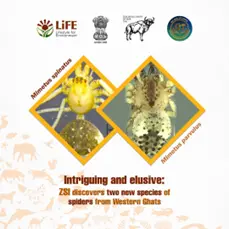
About Mimetus spinatus and Mimetus parvulus:
- Discovery:
- Mimetus spinatus was collected from the Mookambika Wildlife Sanctuary in Karnataka, while Mimetus parvulus was found in the Ernakulam district of Kerala.
- Features:
- Family: Both species belong to the spider family Mimetidae, commonly known as pirate or cannibal spiders due to their predatory behaviour.
- Predatory Behaviour: These spiders infiltrate the webs of other spiders, mimicking vibrations to deceive and prey on the host spider.
- Mimetus spinatus:
- Size: Medium.
- Appearance: Pale yellow head, dull grey-white abdomen with light green mottling.
- Distinctive Feature: Long, black, flattened spine-like hairs on the dorsal head, which inspired the species' name.
- Mimetus parvulus:
- Appearance: Pale creamy-rose head with dense grey-black mottling, triangular-shaped dull grey-white abdomen.
- Significance:
- The discovery of Mimetus spinatus and Mimetus parvulus marks the first report of the genus Mimetus in India after 118 years, following the discovery of Mimetus indicus.
- The addition of these two species brings the total number of Mimetus species in India to three, all found in the southern region of the country.
Source: MP
India's E-commerce has done more good than harm
Context:
- The Indian e-commerce industry is projected to reach USD 350 billion by 2030.
- This growth has led to concerns from India's Commerce Minister about its impact on traditional retail and small businesses, despite previous government support for the sector.
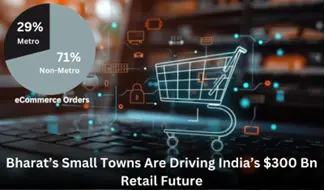
- E-commerce has also disrupted traditional distribution, allowing smaller Indian brands to compete with established players and fostering a consumer-centric market with reduced risk of predatory practices.
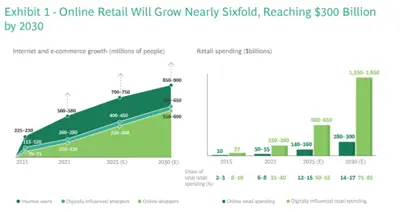
What is E-Commerce?
- About:
- E-commerce, or electronic commerce, involves the buying and selling of goods or services over the internet, including the transfer of money and data to complete these transactions.
- Types of E-Commerce
- Based on Parties Involved:
- Business-to-Consumer (B2C): E.g., Amazon selling products directly to individual customers.
- Business-to-Business (B2B): E.g., Wholesalers selling to retailers through online platforms.
- Consumer-to-Consumer (C2C): E.g., Individuals selling items on platforms like eBay or OLX.
- Consumer-to-Business (C2B): E.g., Freelancers providing services to companies via platforms like Upwork.
- Business-to-Government (B2G): E.g., Companies bidding for government contracts online.
- Based on Platform:
- Social Commerce: Utilising social media platforms for e-commerce, such as Facebook Marketplace.
- Mobile Commerce (M-Commerce): Conducting transactions through mobile devices.
- Local Commerce: Connecting local buyers and sellers via online platforms, like Nextdoor.
- Based on Parties Involved:
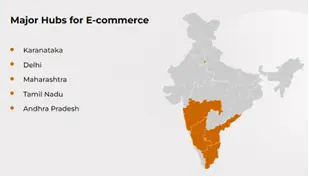
What are the Major Growth Drivers of E-commerce in India?
- Digital Revolution - Smartphones and Internet Penetration:
- India’s digital transformation, marked by widespread smartphone use and low mobile data costs (Rs 13.98 per GB), is driving e-commerce growth.
- By 2026, India is expected to have 1 billion smartphone users, with rural areas leading this surge.
- Initiatives like the Open Network for Digital Commerce (ONDC) are also working to democratise digital commerce.
- Rise of Digital Payments - UPI and Beyond:
- The increase in digital payments, highlighted by Unified Payment Interface (UPI) processing 14.04 billion transactions worth Rs 20.45 trillion in May 2024, has been crucial for e-commerce.
- Digital payment systems and platforms like BHIM have decreased reliance on cash-on-delivery, simplifying transactions and expanding the customer base.
- Evolving Consumer Behavior - Convenience and Choice:
- Changing lifestyles and time constraints are shifting consumer preferences towards online shopping for its convenience and variety.
- E-commerce platforms, including Amazon India with over 170 million products, offer competitive pricing and doorstep delivery, appealing to both urban and rural customers.
- Logistics and Last-Mile Delivery Innovation:
- The logistics sector, projected to grow from USD 250 billion in 2021 to USD 380 billion by 2025, supports e-commerce expansion.
- Innovations such as hyperlocal delivery (e.g., Dunzo, Swiggy Instamart) have improved delivery speeds to 10-30 minutes in some areas.
- Rise of Social Commerce and Live Shopping:
- Social commerce is growing, with platforms like Meesho using social networks for product sales.
- Live shopping, driven by platforms like Flipkart’s Shopsy and integrated YouTube features, is projected to be a USD 4-5 billion market by 2025, particularly attracting young, digitally-native consumers.
- Personalisation and AI-Driven Recommendations:
- AI and data analytics enhance the online shopping experience through personalisation, with giants like Amazon deriving 35% of sales from personalised recommendations.
- AI-powered chatbots manage 30-40% of customer queries, boosting satisfaction and conversion rates.
- Vernacular Approach and Voice Commerce:
- Addressing India's linguistic diversity through voice-based shopping (e.g., Amazon Alexa, Google Assistant) opens new markets.
- With 57% of internet users preferring Indian languages, vernacular e-commerce solutions present significant opportunities.

What are the Major Issues Related to the E-Commerce Sector in India?
- Predatory Pricing - The Race to the Bottom:
- Major e-commerce players face allegations of predatory pricing, leading to a Competition Commission of India (CCI) probe into Amazon and Flipkart in 2020 for deep discounting practices.
- For example, during the 2022 festive season, discounts up to 80% on electronics raised concerns about long-term market health and fair competition despite short-term consumer benefits.
- Data Privacy - The Double-Edged Sword of Personalisation:
- E-commerce platforms collect extensive user data for personalisation, raising significant privacy and security concerns.
- High-profile breaches, such as the alleged 2021 Domino’s India breach affecting 180 million orders, highlight the risks of balancing personalisation with data protection.
- Counterfeit Conundrum:
- The prevalence of counterfeit products on e-commerce sites undermines brand integrity and consumer trust.
- A 2018 survey found 38% of consumers received fake products, prompting a 2022 Parliamentary recommendation for stricter penalties for selling counterfeits. Effectively managing millions of listings without harming legitimate sellers remains challenging.
- The Small Retailer Squeeze:
- E-commerce giants' growth pressures India's 63 million small retailers, with only 2-3% of MSMEs selling online in FY23.
- Government initiatives like ONDC aim to level the playing field, but small retailers struggle to compete with the tech and scale advantages of large e-commerce firms.
- Last-Mile Logistics - The Rural Reach Riddle:
- Reaching India’s rural population remains difficult due to poor infrastructure, inadequate addresses, and limited warehousing.
- Innovations such as Amazon’s I Have Space and Flipkart’s kirana partnerships help, but delivering efficiently to rural areas, where 65% of the population resides, remains challenging.
- The Environmental Cost of Convenience:
- The e-commerce boom raises environmental concerns, including significant packaging waste and high carbon footprints from last-mile deliveries.
- India generated 3.4 million tonnes of plastic waste in 2019-20, with e-commerce contributing substantially, and quick commerce exacerbates the carbon footprint.
- The Gig Economy Grapple:
- The rise of the gig economy in e-commerce logistics introduces issues regarding worker rights, job security, and safety, especially with rapid delivery promises.
- Gig workers, often isolated and lacking unionisation, face difficulties in advocating for better conditions and fair remuneration.
- The Influencer Impact:
- Influencer marketing's growing role raises concerns about authenticity and disclosure, with issues of undisclosed paid partnerships and misleading endorsements.
- The Advertising Standards Council of India (ASCI) reported that 30% of influencer posts breached disclosure guidelines, challenging the sector to balance influencer power with consumer trust and regulatory compliance.
What are the Government Initiatives Related to the E-Commerce Sector in India?
- Foreign Direct Investment (FDI) in E-Commerce:
- The Indian government permits 100% FDI in the e-commerce marketplace model, specifically for B2B transactions, facilitating foreign investment in the sector.
- Government e-Marketplace (GeM) Portal:
- Launched in August 2016 by the Ministry of Commerce and Industry, the GeM portal promotes transparency and efficiency in public procurement, with procurement exceeding ₹2 lakh crore in FY23.
- Open Network for Digital Commerce (ONDC):
- Introduced in 2022, ONDC aims to democratise e-commerce by providing equal opportunities for MSMEs, enhancing their ability to compete in the digital marketplace.
- Consumer Protection (E-commerce) Rules 2020:
- These rules require e-commerce platforms to display the country of origin and disclose product listing parameters, ensuring greater transparency for consumers.
- Equalisation Levy Rules 2016 (Amended in 2020):
- Imposes a 2% tax on foreign e-commerce operators selling goods or services in India, ensuring fair taxation of digital businesses.
- RBI Guidelines on Payment Aggregators and Gateways:
- Issued by the Reserve Bank of India in 2020, these guidelines regulate payment aggregators and gateways, mandating licensing, stricter operational standards, and improved customer grievance mechanisms.
- National E-Commerce Policy:
- The forthcoming National E-Commerce Policy, proposed in 2018 and with a draft released in 2019, aims to boost sector growth and exports, setting a strategic framework for e-commerce development.
What Measures can be Adopted Related to the E-Commerce Sector in India?
- Levelling the Playing Field for Small Retailers:
- Launch "Digital Kirana" to equip small retailers with digital tools.
- Partner with e-commerce platforms to feature local sellers.
- Subsidise access to e-commerce platforms, digital payments, and inventory software.
- Implement tiered commissions on e-commerce platforms, lowering rates for small sellers.
- ONDC Acceleration - Democratizing Digital Commerce:
- Fast-track ONDC implementation in major cities.
- Provide financial incentives for early adopters and tech providers.
- Launch a nationwide campaign to educate on ONDC benefits.
- Streamlining the E-Commerce Ecosystem:
- Develop a comprehensive e-commerce policy covering FDI, data localization, and cross-border trade.
- Establish an e-commerce regulatory body for compliance and competition.
- Simplify GST compliance, potentially with a single-point collection mechanism.
- Last-Mile Innovation Fund - Bridging the Rural-Urban Divide:
- Create a "Last-Mile Innovation Fund" for rural delivery solutions.
- Offer tax incentives for rural logistics investments, including micro-warehouses.
- Partner with India Post for rural e-commerce deliveries and create "rural e-commerce assistants."
- Green E-Commerce Push:
- Implement a "Green Rating" system for eco-friendly packaging.
- Introduce tax benefits for using electric vehicles in delivery.
- Launch "Circular E-Commerce" to promote refurbished goods and incentivize recycling.
- Consumer Protection Enhancement:
- Strengthen dispute resolution with online consumer courts.
- Introduce blockchain-based product verification for high-value items.
- Mandate clear pricing disclosures, including base prices, discounts, and fees.
- Inclusive Gig Economy Framework:
- Develop a social security scheme for gig workers, including health and retirement benefits.
- Implement a "Portable Benefits" system for multi-platform benefits.
- Establish minimum wage guidelines for gig workers.
- Launch a "Gig Worker Upskilling Program" for skill development and career advancement.
|
UPSC Civil Services Examination, Previous Year Question: Prelims Q:1 With reference to foreign-owned e-commerce firms operating in India, which of the following statements is/are correct? (2022)
Select the correct answer using the code given below:
Ans: (b) |
Source: TH
Share the article
Edukemy’s Current Affairs Quiz is published with multiple choice questions for UPSC exams
MCQ
Get Latest Updates on Offers, Event dates, and free Mentorship sessions.

Get in touch with our Expert Academic Counsellors 👋
FAQs
UPSC Daily Current Affairs focuses on learning current events on a daily basis. An aspirant needs to study regular and updated information about current events, news, and relevant topics that are important for UPSC aspirants. It covers national and international affairs, government policies, socio-economic issues, science and technology advancements, and more.
UPSC Daily Current Affairs provides aspirants with a concise and comprehensive overview of the latest happenings and developments across various fields. It helps aspirants stay updated with current affairs and provides them with valuable insights and analysis, which are essential for answering questions in the UPSC examinations. It enhances their knowledge, analytical skills, and ability to connect current affairs with the UPSC syllabus.
UPSC Daily Current Affairs covers a wide range of topics, including politics, economics, science and technology, environment, social issues, governance, international relations, and more. It offers news summaries, in-depth analyses, editorials, opinion pieces, and relevant study materials. It also provides practice questions and quizzes to help aspirants test their understanding of current affairs.
Edukemy's UPSC Daily Current Affairs can be accessed through:
- UPSC Daily Current Affairs can be accessed through Current Affairs tab at the top of the Main Page of Edukemy.
- Edukemy Mobile app: The Daily Current Affairs can also be access through Edukemy Mobile App.
- Social media: Follow Edukemy’s official social media accounts or pages that provide UPSC Daily Current Affairs updates, including Facebook, Twitter, or Telegram channels.

